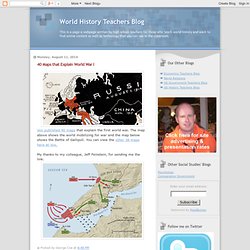Zoom
Trash

Archdukes, Cynicism, and World War I: Crash Course World History #36. Lives of the First World War 'digital memorial' goes live. 11 May 2014Last updated at 23:53 ET An online archive remembering the millions of people from Britain and the Commonwealth who served in World War One has gone live.

Four-and-a-half million British army members are already included in the Lives of the First World War project. But for many entries there is little more information than their names. Organiser Imperial War Museums (IWM) wants families to add their own photographs, stories and memories to build a "permanent digital memorial". The records of more than 4.5 million men and 40,000 women who served with the British army overseas are currently listed. Famous World War I Battle Sites A Century Later. A 100-Year Legacy of World War I. Over the Top - A First World War Free Online Adventure Game. Introduction.

A global guide to the first world war - interactive documentary. 40 Maps that Explain World War I. Vox published 40 maps that explain the first world war.

The map above shows the world mobilizing for war and the map below shows the Battle of Gallipoli. You can view the other 38 maps here at Vox. My thanks to my colleague, Jeff Feinstein, for sending me the link. World War I Centenary: 100 Legacies of the Great War. World War I changed everything.

From new countries to literature, from tanks to treaties and from flamethrowers to fashion, the conflict is still writ large on our lives 100 years on. It gave birth to violent dictators and their ideologies but extended the electoral franchise to millions. It ushered in the era of mechanised warfare whilst laying the foundations for modern medicine. Empires crumbled, borders were redrawn, art movements flowered and women won the vote (even if you still had to be over 30 in some countries). Poets committed some of the most memorable imagery in modern verse to paper while a generation of writers would descend on Europe’s war-torn cities and fashion a new style of literature. After millions of men gave their lives on the battlefields of Europe, it was doubly tragic that a deadly influenza would claim up to 50 million more deaths in the conflict’s immediate aftermath.
Writers Editors Multimedia Producers Designers & Developers Consultant. WWI. World War II: Crash Course World History #38. The Treaty of Versailles in 1918 and its Consequences. WWII. Free World War 2 Course. History: World War Two. 1900 - present: The recent past. Science and Technology of WWII. Denmark in World War II. During much of World War II, Denmark was occupied by Nazi Germany.

The occupation began with Operation Weserübung on April 9 1940, and lasted until German forces withdrew at the end of World War II following their surrender to the Allies on 5 May 1945. Contrary to the situation in other countries under German occupation, most Danish institutions continued to function relatively normally until 1943. Both the Danish government and king remained in the country in an uneasy relationship between a democratic and a totalitarian system until German authorities dissolved the government following a wave of acts of sabotage and labour strikes. An effective resistance movement developed by the end of the war, and most Danish Jews were rescued in 1943 when German authorities ordered their internment as part of the Holocaust. Invasion[edit] Danish soldiers man an anti-aircraft gun.
The occupation of Denmark was initially not an important objective for the German government. Faroe Islands[edit] World War II Code Is Broken, Decades After POW Used It : The Two-Way. Hide captionAs a prisoner of war, Sub Lieut.

John Pryor encrypted information and requests for supplies in letters sent from a German camp to his family in Cornwall. Plymouth University As a prisoner of war, Sub Lieut. John Pryor encrypted information and requests for supplies in letters sent from a German camp to his family in Cornwall. It's been 70 years since the letters of John Pryor were understood in their full meaning. Pryor's letters served their purpose in World War II, as Britain's MI9 agents decoded the messages hidden within them — requests for supplies, notes about German activities — before sending them along to Pryor's family in Cornwall. "There were two types of information buried in these letters," Pryor's son, Stephen, tells Weekend Edition Saturday's Scott Simon. After the war, Pryor lived a long life; he died in 2010 at age 91. World War II Uniforms - A-Z. The following lists the uniforms of every country that participated in World War II.

It is an ongoing list and will be re-posted every time it is updated.Abyssinia - 1941, Ethiopia, Private, Abyssinian Patriot ArmyAustralia - 1941 Jan., North Africa, Private, 6th DivisionAustralia - 1941 Mar., Syria, Private, 7th DivisionAustralia - 1941 May, Tobruk, Private, 9th Division Australia - Sergeant of the 47th Battalion, 2nd Australian Imperial Force Source Maryborough Military and Colonial Museum. The Corpse That Fooled Hitler. On the morning of April 30, 1943, a fisherman working off the coast of Huelva, Spain found a body floating in the water. The corpse, an adult male, was badly decomposed and wearing a military uniform, trench coat, and boots. Floating nearby, and attached to the man’s trench coat belt with a chain, was a briefcase. Theresienstadt concentration camp. Coordinates : 50°30′48″N 14°10′1″E / 50.51333°N 14.16694°E / 50.51333; 14.16694 The (2005) , also referred to as Theresienstadt Ghetto, [ 1 ] [ 2 ] [ 3 ] was established by the SS during World War II in the fortress and garrison city of Terezín (German name ), located in what is now the Czech Republic.
During World War II it served as a Nazi concentration camp staffed in equal numbers by German Nazi guards and their ethnic Czech collaborators. Tens of thousands of Jews were murdered there and over 150,000 others (including tens of thousands of children) were held there for months or years, before then being sent to their deaths on rail transports to Treblinka and Auschwitz extermination camps in Poland, as well as to smaller camps elsewhere. [ edit ] History. Rescue of the Danish Jews. The rescue of the Danish Jews occurred during Nazi Germany's occupation of Denmark during World War II.

On October 1, 1943 Nazi leader Adolf Hitler ordered Danish Jews to be arrested and deported. Despite great personal risk, the Danish resistance movement, with the assistance of many ordinary Danish citizens, managed to evacuate 7,220 of Denmark's 7,800 Jews, plus 686 non-Jewish spouses, by sea to nearby neutral Sweden.[1] The rescue allowed the vast majority of Denmark's Jewish population to avoid capture by the Nazis and is considered to be one of the largest actions of collective resistance to repression in the countries occupied by Nazi Germany.
As a result of the rescue, and the following Danish intercession on behalf of the 464 Danish Jews who were captured and deported to Theresienstadt transit camp in Bohemia, over 99% of Denmark's Jewish population survived the Holocaust.[1] Memorial in "Denmark Square", Jerusalem The "model protectorate" (1940–1943)[edit] Military History (20th Century) World War 2. WORLD WAR 2.